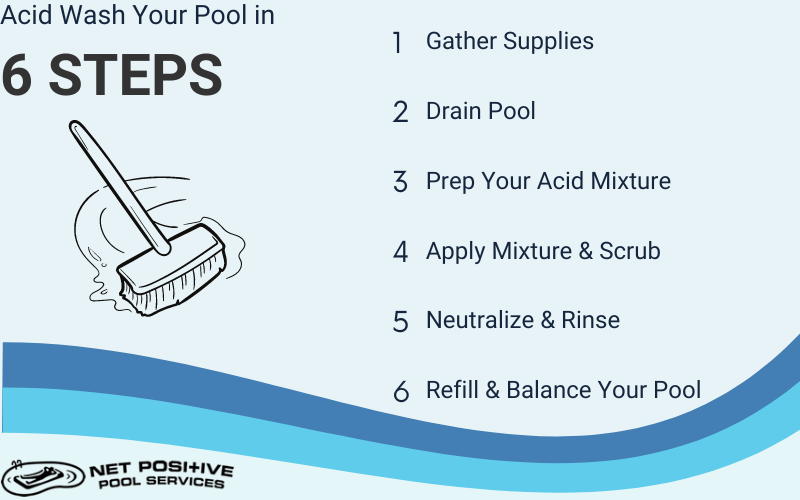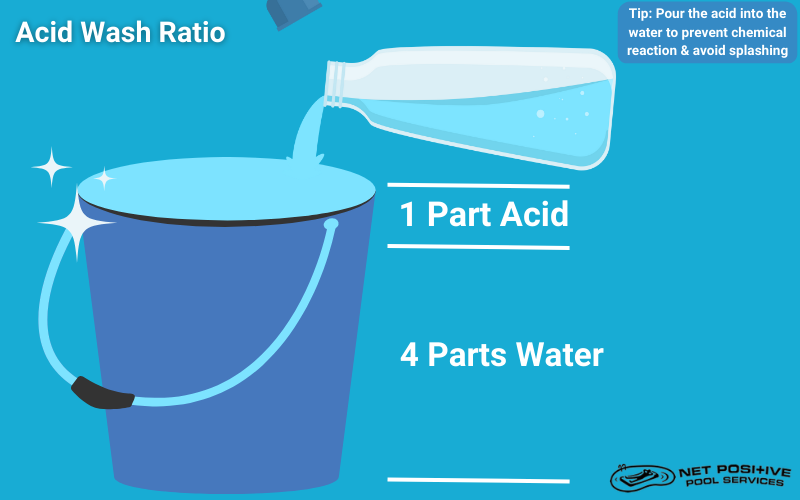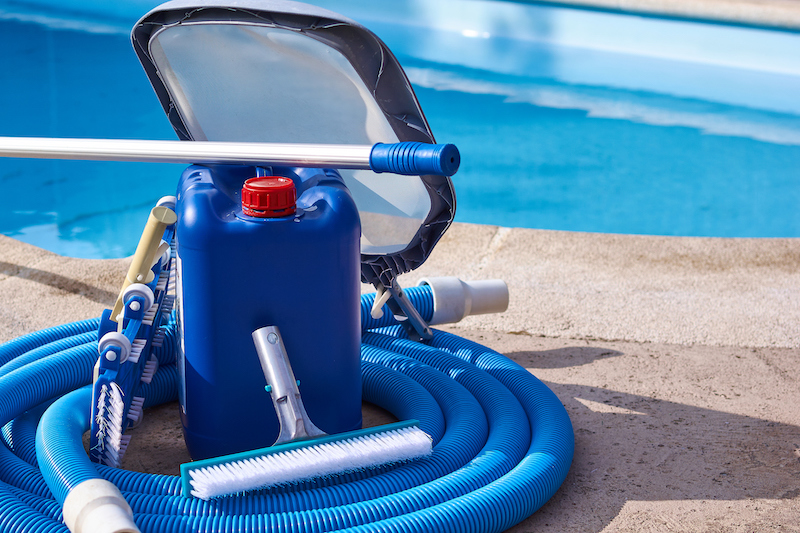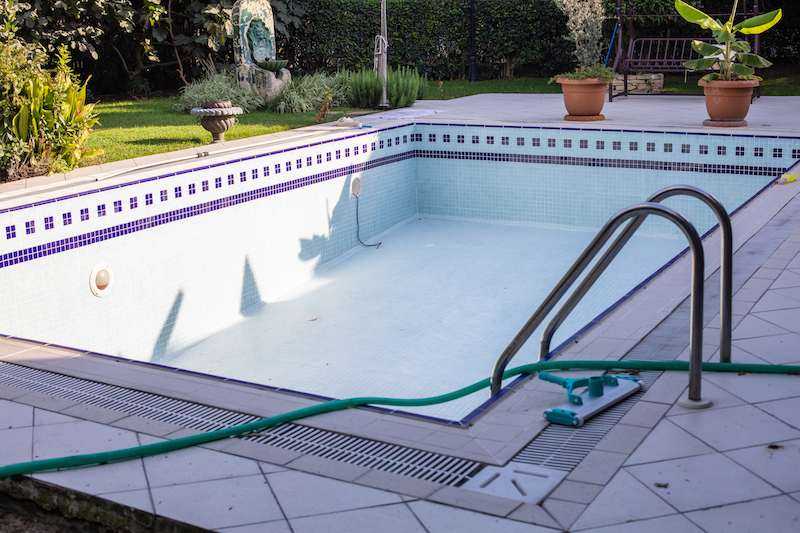Jump To
Are you tired of seeing your once vibrant swimming pool looking dull and uninviting? You’ve tried everything, but the stains and mineral deposits just won’t go away. You might need an acid wash, but how do you acid wash your pool?
Acid washing is a process that revitalizes your pool and brings back the shine by stripping a thin layer of plaster off the surface, thus removing
- Mineral stains
- Copper stains
- Algae growth
The process includes draining your pool using a submersible pump, removing hydrostatic relief plugs, preparing the acid mixture, and carefully brushing the surface of your pool with an acid brush. Of course, safety precautions are integral, as the acid used in this process is a harsh chemical often referred to as muriatic acid or hydrochloric acid.

Step-by-Step Guide to The Acid Washing Process
Sometimes, regular cleaning and pool maintenance aren’t enough, especially when dealing with stubborn mineral deposits or persistent algae blooms. When this happens, a full acid wash may be the solution. Despite sounding daunting, performing an acid wash can be manageable, provided you follow the right steps and precautions.
Step 1: Gear Up
Your safety as a pool owner comes first. Start by preparing all your protective gear and supplies:
- Non-abrasive pool brush
- Garden hose
- Submersible pump
- Gloves
- Rubber boots
- Goggles
- Mask
- Acid solution
- Soda ash
- Sub pump
- Bucket
- Any additional whitening agents you might require
Protective clothing is required to handle harsh chemicals safely. Once you’ve gathered your supplies, you can continue with the process.
Step 2: Drain Your Pool
Drain your pool using the submersible pump and remove pool lights to avoid corroding the metal.
Step 3: Prepare Your Acid Mixture
Acid washing involves using a solution of muriatic acid and water. A common acid-to-water ratio is 1:4, but it may vary depending on the extent of staining and the surface condition. Mix your acid and water in the empty pool to avoid damage to the pool decking. This is also the time to add any additional whitening agents you may require to the mixture, but this step is not necessary.
*TIP* Be sure to add acid to water and not vice versa to prevent a strong chemical reaction.
Step 4: Acid Wash the Surface
Begin by wetting a small section of the pool wall with the hose, then apply the acid mixture in a circular pattern using a bucket and the acid brush. It’s important not to leave acid on the plaster surface for more than 30 seconds. Rinse thoroughly as soon as it starts to fizz or change color. Go section by section scrubbing and rinsing with water immediately after to avoid streaks.
Step 5: Neutralize and Rinse
After acid washing and rinsing the pool, you need to neutralize the acid from the pool. Use a neutralizing product, like soda ash or pH increaser, following the detailed instructions to achieve an optimal pH balance. If you still have stubborn stains, consider repeating the previous steps.
Step 6: Refill and Balance Your Pool
When acid washing is all done, it’s time to refill your pool. Post acid wash, make sure you balance your pool water and test it to ensure its chemistry is correct and safe for swimming.
Remember – dealing with chemicals like muriatic acid should be handled with extreme care. It’s a powerful solution that can result in acid fumes that should not be inhaled. If you are not comfortable handling these chemicals, consider reaching out to professionals. Precaution is always better, especially when dealing with chemicals that can potentially harm you and your pool.

Why You Need to Acid Wash Your Pool?
You might wonder why it’s necessary to go through such a detailed process for your pool. The reality is – over time, swimming pools inevitably require a bit more than just a skim and scrub.
Mineral Deposits
Mineral deposits and stains accumulate on the pool walls and floor over time, creating unsightly discolorations that are often difficult to remove with regular pool cleaning methods. The frequent addition of chemicals, such as chlorine, combined with organic matter like leaves and pollen, can contribute to the buildup of these deposits and stains turning your once bright and clear pool into an unappealing sight.
Algae Growth
Another compelling reason to acid wash your pool is to tackle the stubborn problem of algae growth. When conditions are right (warm weather and untreated water), algae can make their home in your pool, growing rapidly and giving your pool a swampy green hue. Regular cleaning can help, but sometimes the algae are so deeply rooted in the plaster that only a thorough acid wash goes deep enough to eliminate these stubborn, unwanted guests.
Regular Maintenance
The draining and cleaning process involved in acid washing offers the perfect opportunity to inspect your pool surface for any damage such as cracks, chips, or flaws that need to be addressed. If there’s any hidden damage you weren’t aware of, it’s better to find it during an acid wash than after it has caused significant problems down the line.
Whether it’s the clean, bright finish, or healthier swimming conditions, the benefits of acid washing are clear. However, it’s crucial to note that as effective as acid washing is, it is also a harsh process, stripping a thin layer from your pool’s surface. That’s why it shouldn’t be a routine task. Most pool professionals advise that unless there’s a specific issue, like stubborn stains or persistent algae, pools shouldn’t be acid-washed more than once every three to five years.

Professional Pool Services: Simplifying Acid Washing
While the DIY approach may be enticing for some, it’s crucial to remember that handling harsh chemicals like muriatic acid requires careful handling and time. Whether it’s correctly balancing the concentration of your acid mixture, safely applying the acid, or dealing with unexpected problems that may arise during the process, like persistent copper stains or extensive mineral deposits, the expertise of a professional service provider can be invaluable.
Net Positive Pool Services for Acid Washing
This is where Net Positive Pools can help! We not only have the equipment and knowledge necessary to handle all stages of pool acid washing safely and effectively, but our years of expertise also enable us to tackle individual challenges based on the specific condition of your pool.
Customized Approach
Our team recognizes that every pool is unique. What works for a pebble tec surface may be disastrous for a plaster pool, and vice versa. Hence, we approach acid washing with a detailed understanding of different pool materials and how they react to the acid, ensuring a safe and thorough process that considers the specific conditions and requirements of your pool.
Our value outweighs the costs and challenges associated with pool maintenance. As part of this commitment, our expert services are just a call away, ready to help you tackle pool stains, calcium buildup, or algae bloom, no matter where you’re located, be it in Huntersville, NC, Greenville, SC, Statesville, NC, York, SC, or Charleston, SC.
Additional Pool Services
Aside from acid washing, we can automate your pool, repair and install equipment, and recommend products at our brick-and-mortar store in Huntersville. Our team can manage every aspect of your pool system: pumps, lights, heaters, filters, you name it.
Our weekly pool maintenance program can reduce the need for frequent acid washing, helping to keep your pool sparkling clean and prolonging the lifespan of its surfaces.
So whether it’s your first acid wash or you’re looking for regular maintenance, we are here to help.
Contact Net Positive Pools to learn more about our acid washing or additional services today!
References
Anne Marie Helmenstine, Ph.D. “Adding Acid to Water Safely.” ThoughtCo, ThoughtCo, 9 Aug. 2019, www.thoughtco.com/do-you-add-acid-to-water-608152.


